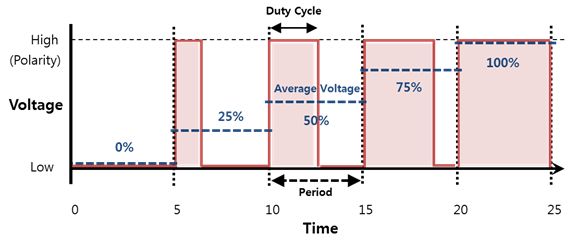PWM
PWM (Pulse-Width Modulation) is a programmable interface that allows you to, for example, control motor speed or change light brightness.
Peripherals that support PWM are controlled by the current strength. To modulate the current, the voltage needs to be modulated. The voltage is proportional to the intensity of the current.
To modulate the voltage, you must set the duty cycle and polarity:
- The period is a constant interval at which the pulse repeats.
- The duty cycle is the constant time within 1 period in which a signal is active.
- A “polarity high” signal starts high for the duration of the duty cycle and goes low for the remainder of the period. Conversely, a “polarity low” signal starts low for the duration of the duty cycle and goes high for the remainder of the period.
- The pulse repeats if repetition has been enabled.
Figure: Duty cycle

For example, if the period is 10,000,000 nanoseconds and the polarity high duty cycle is 7,000,000 nanoseconds, the average voltage is at 70%.
Figure: Average voltage per duty cycle

Opening and Closing a Handle
To open and close a handle:
-
To open a PWM handle, use the
peripheral_pwm_open()function:int chip = 0; int pin = 2; peripheral_pwm_h pwm_h; peripheral_pwm_open(chip, pin, &pwm_h);Note
For more information on the pin names and locations, see Supported Protocols.
-
To close a PWM handle that is no longer used, use the
peripheral_pwm_close()function:peripheral_pwm_close(pwm_h);
Setting the Period
To set the period, use the peripheral_pwm_set_period() function.
The following example sets the period to 20 milliseconds. The unit is nanoseconds.
Uint32_t period = 20000000;
peripheral_pwm_set_period(pwm_h, period);
Setting the Duty Cycle
To set the duty cycle, use the peripheral_pwm_set_duty_cycle() function.
The following example sets the duty cycle to 2 milliseconds. The unit is nanoseconds.
uint32_t duty_cycle = 2000000;
peripheral_pwm_set_duty_cycle(pwm_h, duty_cycle);
Setting the Polarity
To set the polarity, use the peripheral_gpio_set_polarity() function with 1 of the following polarity types:
PERIPHERAL_PWM_POLARITY_ACTIVE_HIGH: Polarity is high.PERIPHERAL_PWM_POLARITY_ACTIVE_LOW: Polarity is low.
peripheral_pwm_set_polarity(pwm_h, PERIPHERAL_PWM_POLARITY_ACTIVE_HIGH);
Enabling Repetition
To enable repetition, use the peripheral_pwm_set_enabled() function:
bool enable = true;
peripheral_pwm_set_enabled(pwm_h, enable);